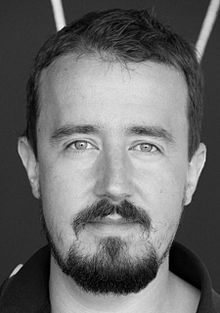Vincent Callebaut
| Vincent Callebaut | |
|---|---|
 |
|
| Born |
May 27, 1977 La Louvière |
| Nationality | Belgian |
| Alma mater | Université libre de Bruxelles |
| Occupation | Architect |
| Awards | Prix Godecharle (2001), International Architecture Awards (2014) |
| Buildings | Agora Garden Taipei |
| Projects | Dragonfly, Lilypad, King Forest |
Vincent Callebaut (b. May 27, 1977 - ) is a Belgian ecological architect. He designs futuristic-like ecodistrict projects which take account of several aspects of sustainability (renewable energies, biodiversity, urban agriculture).
Vincent Callebaut was born in 1977 in Belgium. He graduated in 2000 from the Institute Victor Horta, he moved to Paris to intern with architects Odile Decq and Massimiliano Fuksas and then founed his own company, « Vincent Callebaut Architectures ».
The project consists on implementing "vertical farms" in Manhattan along the East River at the South edge of the Roosevelt Island. In a way to rethink the city's food production and encourage each inhabitant to participate to the gardens, one of the visions of the Dragonfly project was defined as: 'Eating an apple just picked out of a collective orchard in the fourth floor while looking at New York through the window and then go back to your office just in the upper floor.' This project was inspired by the Japanese movie "Laputa : Castle in the sky".
The Dragonfly building is 575 metres (1,886 ft) high, shaped as firefly wings. It is composed of two towers related by a 'bio-climatic' glasshouse. It deploys itself between two crystalline wings made out of glass and steel. The structure in honeycomb stitch allows the sunlight to pass through the building. This concept is seen as a feeder farm and reconnects the consumers with producers. This prototype of urban farm would have superimposed 132 floors and estending 600 metres (2,000 ft) vertically with garden vegetables, fields, production of meat, milk, poultry and eggs where people could grow their own food. The Dragonfly can accommodate 28 different agricultural fields for the production. It is self-sufficient in energy, water and bio-fertilizing, powered by sunshield and eolian systems. These combine solar and wind power, which would make the Dragonfly self-sufficient. Everything is recyclable in a continuous auto-feeding so that nothing is lost. The spaces between the wings are designed to take advantage of solar energy by accumulating warm air in the structure during winter. During the summer it is cooling which is facilitated through natural ventilation and "evapo-perspiration" from the plants.
The objectives of the Dragonfly project were defined as:
The Lilypad or Floating ecopolis project is based on the idea of creating a place for future refugees of Current sea level rise caused by Global warming.
...
Wikipedia
